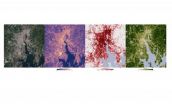The study was cosponsored by the National Institute of Allergy and Infectious Diseases (NIAID) and the National Heart, Lung, and Blood Institute (NHLBI), two components of the National Institutes of Health, and appears online in the Journal of Allergy and Clinical Immunology.
"Asthma was the most common underlying health condition among those hospitalized in the United States with 2009 H1N1 influenza infection during the 2009-2010 influenza season," says NIAID Director Anthony S. Fauci, M.D. "The results of this clinical trial show that the 2009 H1N1 influenza vaccine was safe and led to adequate production of antibodies thought to be protective against the virus. This is important because the H1N1 vaccine is one component of the seasonal influenza vaccine currently being distributed for the 2010-2011 influenza season."
People with asthma are at risk for developing severe disease when infected with the influenza virus. In addition, there is concern that the long term use of corticosteroids, which are used to control asthma symptoms and known to suppress the immune system, by people with severe asthma might affect their ability to mount a healthy immune response to the vaccine.
"This study shows patients and their doctors that it is safe and effective to get the flu vaccination while they continue to take the corticosteroid medications necessary to keep their asthma under control," says NHLBI Acting Director Susan B. Shurin, M.D.
In late 2009, NIH rapidly designed and sponsored a clinical study to determine the dose and number of doses of the 2009 H1N1 influenza vaccine needed to safely produce a protective immune response in people with asthma. NIH worked with the Department of Health and Human Services Biomedical Advanced Research and Development Authority to acquire H1N1 vaccine for the study from a U.S.-licensed influenza vaccine manufacturer. The trial was conducted at NHLBI Severe Asthma Research Program (SARP) sites located at university hospitals and centers throughout the United States.
The design of the trial was similar to that of other NIAID-sponsored clinical trials of 2009 H1N1 influenza vaccines in healthy adults. In these trials, a single dose of the vaccine containing 15 micrograms of the influenza hemagglutinin molecule—the main target of the protective antibody response—was found to be well tolerated and induced a strong immune response in most participants.
The study enrolled 390 people aged 12 to 79 years with asthma. Participants were divided into two groups based on the severity of their asthma. The first group exhibited mild or moderate asthma, and the second group exhibited severe asthma. For the purposes of the study, people with mild or moderate asthma were characterized as needing no or low to moderate doses of inhaled corticosteriods to control their disease symptoms. Those with severe asthma needed high doses of inhaled corticosteriods and frequently required oral corticosteriods to control their symptoms.
Half of the participants in each group received a 15-microgram dose of vaccine, and the other half received a 30-microgram dose, both by injection. Three weeks later, each participant received a second dose in the same amount as the first dose. The vaccine, manufactured by Novartis by methods used to prepare each year's seasonal vaccine, contained inactivated 2009 H1N1 influenza virus and therefore could not cause influenza infection.
The investigators measured the level of antibodies against the 2009 H1N1 influenza virus in participants' blood samples, which were taken three weeks after each injection, to assess the strength of the immune response.
The vaccine proved safe and effectively produced an immune response indicative of protection. In participants with mild to moderate asthma, and in most participants with severe asthma, a single 15-microgram dose was sufficient to induce a presumably protective immune response. The immune response after the first dose was not further improved after a second dose, indicating that a single dose was adequate. Participants older than age 60 with severe asthma had diminished immune responses to the 15-microgram dose of vaccine, but the 30-microgram dose gave an adequate response.
"We were not surprised that the older participants had less robust responses to the vaccine compared with the younger participants because immune system activity tends to decrease with age," says William Busse, M.D., a principal investigator of NHLBI's SARP and professor of medicine at the University of Wisconsin in Madison. "Based on these observations, physicians may wish to consider immunizing older patients who have severe asthma with the high-dose version of the 2010-2011 seasonal influenza vaccine, which contains the 2009 H1N1 influenza virus component."
Safety data were collected and examined throughout the course of the study by investigators and by an independent safety monitoring committee. Participants were followed for any side effects they may have experienced from the vaccine, as well as for asthma attacks that occurred during the study. The vaccine did not exacerbate participants' asthma. In addition, the vaccine was well-tolerated, and its safety profile was found to be the same as that obtained in other studies in which the vaccine was given to the general public. ###
Detailed information about this study can be found at ClinicalTrials.gov (http://clinicaltrials.gov/ct2/show/NCT00978120?term=H1N1+AND+asthma&rank=1) and on Questions and Answers: NIH Trial of 2009 H1N1 Influenza Vaccine in People with Asthma (http://www.niaid.nih.gov/news/QA/Pages/H1N1VacASTHMAqa.aspx).
Additional information about NIAID-sponsored clinical trials of candidate H1N1 vaccines can be found on NIAID's H1N1 Clinical Studies Web portal (http://www.niaid.nih.gov/topics/flu/h1n1/clinicalstudies/Pages/Default.aspx).
Visit www.flu.gov for one-stop access to U.S. government information on avian and pandemic influenza.
Also, visit NIAID's Web portals for more information about flu (http://www.niaid.nih.gov/topics/flu/Pages/default.aspx) and asthma (http://www.niaid.nih.gov/topics/asthma/Pages/default.aspx) and NHLBI's Web site for more information about asthma (http://www.nhlbi.nih.gov/health/dci/Diseases/Asthma/Asthma_WhatIs.html).
For additional information about NHLBI's SARP, visit the program Web site at http://severeasthma.org/SARP_home.html.
NIAID conducts and supports research—at NIH, throughout the United States, and worldwide—to study the causes of infectious and immune-mediated diseases, and to develop better means of preventing, diagnosing and treating these illnesses. News releases, fact sheets and other NIAID-related materials are available on the NIAID Web site at http://www.niaid.nih.gov.
Part of the National Institutes of Health, the National Heart, Lung, and Blood Institute (NHLBI) plans, conducts, and supports research related to the causes, prevention, diagnosis, and treatment of heart, blood vessel, lung, and blood diseases, and sleep disorders. The Institute also administers national health education campaigns on women and heart disease, healthy weight for children, and other topics. NHLBI press releases, information on NHLBI's role in the American Recovery and Reinvestment Act, and other materials are available online at www.nhlbi.nih.gov.
The National Institutes of Health (NIH)—The Nation's Medical Research Agency—includes 27 Institutes and Centers and is a component of the U. S. Department of Health and Human Services. It is the primary federal agency for conducting and supporting basic, clinical and translational medical research, and it investigates the causes, treatments and cures for both common and rare diseases. For more information about NIH and its programs, visit http://www.nih.gov.
Reference: WW Busse et al. Vaccination of patients with mild and severe asthma with a 2009 pandemic H1N1 influenza virus vaccine. Journal of Allergy and Clinical Immunology. DOI: 0.1016/j.jaci.2010.11.014 (2010)
END



